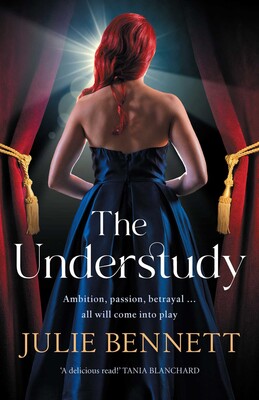A novel that is full of surprises, that appears to be one thing and morphs into another, a genre-bender, is a delight to read because you are never sure quite where the story will take you next. The prologue of The Understudy (Simon and Schuster 2022) by debut author Julie Bennett, is a harrowing and sinister scene of violence that would be at home in any good crime novel. Then, in the first chapter, it switches speeds to an historical romance.
Set in the dual timelines of 1953 and 1973, the narrative centres on rising Australian opera star Sophie Carlton, the understudy for diva Margaret Gardiner who is singing the principal role in Madame Butterfly in front of the queen at the official opening of the Sydney Opera House. Margaret’s leading man is Italian star Armando Cecci, who in turn is understudied by Ben Anson. When Margaret goes missing the day before opening night, and Sophie must play the leading role, she is equal parts thrilled and nervous. This is the big chance she has always hoped one day would come, one that her mentor Lady Napier has been encouraging her to dream for, but it is tainted by the strange events around Margaret’s disappearance and the subtly voiced hints that Sophie herself might have had something to do with it.
The weeks go on and the mystery surrounding Margaret’s disappearance only deepens. There is a cast of wonderfully interesting characters, like an Agatha Christie novel, some with richly drawn backstories and some remaining infuriatingly enigmatic. There is Bruno, Armando’s curious manservant; Janet and Steve, Sophie’s well-meaning friends; the shadowy Geoff; there is the cast and chorus of the opera; and the management team of the operatic organisation. There are many different motivations at play, and some of the characters’ reasons and motives only become obvious as the story unfolds.
The tale goes back and forth in time. The 1970’s is a vibrant and lively decade of openness, feminism and culture – the establishment of the Opera House one step in Australia’s journey towards international recognition in the arts. But the narrative alternates with the story of what happened to one of the characters in the 1950’s, a time of propriety and expectations, of familial obligations; a time when dark secrets form and remain hidden for several decades.
Bennett juggles three distinct genres or styles in this book, and while each competes for precedence, she manages to combine them to create a uniquely crafted story that will appeal to many readers. The first is the most obvious: an historical romance. Both the 50’s and 70’s plots are filled with desire, passion, romance, love, friendship, loyalty, betrayal, lust and power. The sex is impassioned, enthusiastic and fervent; the romantic entanglements are infused with a mix of self-doubt, lust disguised as ambition, endearing love and unsentimental attachments.
The second theme is the sense of place – mostly set in Sydney in the 70’s at the unveiling of the new Opera House in the midst of a vivacious, pulsating and flamboyant artistic time, with the performing arts beginning to make a splash in the social pages. It is here that the author’s own personal experience comes to the fore in informing the writing of this novel – as a child, Bennett was an extra in the operatic War and Peace, one of the first performances at the Opera House, and her sense of music, art, theatre, greasepaint and the dynamics of an artistic community really shine through. In her words, the smell of the building itself, ‘of salt, sea, concrete and earth’, conjure the Green Room and the stage door and the huge concert halls themselves. Peopled with characters with artistic temperaments, dominant egos, thinly veiled jealousies, or frail insecurities, this aspect of the novel sings with authenticity.
And the third – unexpected – thread to this story is almost that of a crime or a whodunnit. Margaret Gardiner’s disappearance and the subsequent search for her, the hunt for whoever may have done her harm, the suspicion that falls on various other characters, and the chilling flashbacks to events 20 years earlier, all contribute to a deliciously sinister tone that only becomes more compelling as the novel goes on. When I began this book, I assumed it would tread a certain path, but by halfway through, it had become obvious that there was much more going on than I had at first thought. The second half of the book is genuinely surprising and unexpected.
And that’s why this novel is a genre-bender – is it romance? Historical fiction? A crime/mystery? An engaging rendering of the artistic life? It is all of these combined, and thus makes for an enjoyable and page-turning read. Fans of Natasha Lester, Kayte Nunn, Alison Booth and Mary-Rose MacColl will enjoy this novel.

